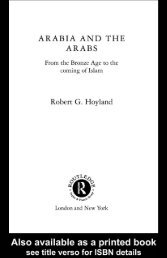The Ambiguity of Teaching to the Test Standards
The Ambiguity of Teaching to the Test Standards
The Ambiguity of Teaching to the Test Standards
Create successful ePaper yourself
Turn your PDF publications into a flip-book with our unique Google optimized e-Paper software.
2. TEACHING MATHEMATICS AND SCIENCE<br />
solving “open-ended” problems) ra<strong>the</strong>r than with fundamental changes in<br />
practice. Simon and Tzur (1999) and Simon, Tzur, Heinz, Kinzel, and<br />
Schwan-Smith (2000) suggested that teachers <strong>of</strong>ten have a limited understanding<br />
<strong>of</strong> what <strong>the</strong> changes advocated by ma<strong>the</strong>matics education researchers<br />
and <strong>the</strong> standards really mean. <strong>The</strong>y say that many teachers<br />
interpret <strong>the</strong> changes that are needed as discouraging telling and showing,<br />
using manipulatives, or having students work in small groups, for example.<br />
Though all <strong>of</strong> <strong>the</strong>se strategies may well contribute <strong>to</strong> a better teaching environment,<br />
taken alone, or even in combination, such strategies may not necessarily<br />
lead <strong>to</strong> greater student learning (Boaler, 2002; Schorr, 2002; Schorr<br />
& Fires<strong>to</strong>ne, 2001; Schorr & Koellner-Clark, 2003; Simon & Tzur, 1999;<br />
Spillane & Zeulli, 1999). <strong>The</strong>se strategies may represent a step in <strong>the</strong> right<br />
direction, but <strong>the</strong> authors <strong>of</strong> <strong>the</strong> Principles and <strong>Standards</strong> for School Ma<strong>the</strong>matics<br />
caution that many <strong>of</strong> <strong>the</strong> pedagogical ideas from <strong>the</strong> NCTM <strong>Standards</strong>—such<br />
as <strong>the</strong> emphasis on discourse, worthwhile ma<strong>the</strong>matical tasks,<br />
or learning through problem solving—have been enacted without deeper<br />
changes in actual classroom practices (NCTM, 2000).<br />
Goldsmith and Shifter (1993) pointed out that developing a better form<br />
<strong>of</strong> teaching requires more than <strong>the</strong> acquisition <strong>of</strong> some new instructional<br />
techniques or strategies. It demands a reconceptualization <strong>of</strong> <strong>the</strong> entire process<br />
<strong>of</strong> teaching and learning, and this entails substantive change in teachers’<br />
knowledge and beliefs about instruction and content (Schorr, 2002;<br />
Schorr & Lesh, 2003; Simon et al., 2000; Simon & Tzur, 1999). But, teaching<br />
practices are not easily modified or revised. Stigler and Hiebert (1999)<br />
argued that teaching is a cultural activity, and cultural activities “evolve<br />
over long periods <strong>of</strong> time in ways that are consistent with <strong>the</strong> stable web <strong>of</strong><br />
beliefs and assumptions that are part <strong>of</strong> <strong>the</strong> culture … and rest on a relatively<br />
small and tacit set <strong>of</strong> core beliefs about <strong>the</strong> nature <strong>of</strong> <strong>the</strong> subject, about<br />
how students learn, and about <strong>the</strong> role that a teacher should play in <strong>the</strong><br />
classroom” (p. 87). Given <strong>the</strong> long his<strong>to</strong>ry <strong>of</strong> relatively stable instructional<br />
practices in this country (cf. Cuban, 1993), it is not surprising that <strong>the</strong><br />
changes that have been reported are more akin <strong>to</strong> <strong>the</strong> adoption <strong>of</strong> new strategies<br />
or techniques ra<strong>the</strong>r than fundamental shifts in practices.<br />
In addition <strong>to</strong> setting forth a vision emphasizing understanding and inquiry-based<br />
learning, state and national standards (AAAS Project 2061,<br />
1993; NCTM, 1989, 2000; NRC, 1996; Rosenstein et al., 1997) also emphasize<br />
new content (e.g., discrete ma<strong>the</strong>matics). Some proponents <strong>of</strong> testing<br />
consider tests <strong>to</strong> be <strong>the</strong> best hope for using <strong>the</strong> authority <strong>of</strong> <strong>the</strong> state <strong>to</strong> improve<br />
teaching and learning. <strong>The</strong>y believe that standards, and associated<br />
standards-based tests, used effectively, can steer teachers and students <strong>to</strong><br />
content areas that are important for modern society but have received inadequate<br />
attention in <strong>the</strong> past (NCTM, 2000). O<strong>the</strong>rs at least hope that tests<br />
may prompt teachers <strong>to</strong> consider more challenging content and activities<br />
that provide an opportunity for students <strong>to</strong> develop an understanding <strong>of</strong><br />
21



